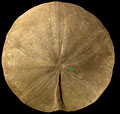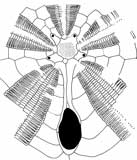|
Diagnostic Features
|
-
Test large, circular, or with blunt posterior margin, low domed to subconical in profile, adoral surface more or less flat.
-
Apical system central, tetrabasal, posterior ocular plates posteriorly prolonged and extending to periproct.
-
Petals long, broad, open distally, with broad, tapering poriferous zones, outer pore slit-like, all ambulacral pores double beneath the petals.
-
Periproct close to apex, surrounded by the posterior plates of the apical disc; opening into deep and sharp anal sulcus that runs from the apex to the posterior margin.
-
Peristome pentagonal, small, slightly anterior to centre.
-
Bourrelets poorly differentiated although interambulacral zones stand out because ambulacral zones are sunken towards peristome; no real zones of dense tuberculation surrounding peristome.
-
Phyllodes double pored, with pore-pairs arranged in arcs of three forming a broad, but not bowed, band.
-
No buccal pores.
|
|
Distribution
|
Jurassic (Bajocian to Oxfordian); Europe, North Africa.
|
| Name gender |
masculine |
| Type |
Clypeus plotii Leske, 1778, p. 157 [=Clypeus sinuatus Leske, 1778, p. 157], by subsequent designation of Kier, 1962, p. 30.
|
| Species Included |
-
C. plotii Leske, 1778; Bajocian-Oxfordian, England, France, Switzerland [includes C. boblayei Michelin, 1857].
-
C. solodurinus (Wright, 1852); Jurassic, England.
-
C. rostellus Currie, 1925; Bathonian to Oxfordian, Somalia, Africa.
-
C. muelleri Wright, 1859; Bajocian-Bathonian, western Europe.
-
C. rostratus Agassiz, in Agassiz & Desor, 1847; Toarcian-Bathonian, Western Europe.
|
| Classification and/or Status |
Irregularia; Neognathostomata; \'clypeids\'.
|
| Remarks |
Clypeus plotii was designated the type species of the genus by Kier. Prior to Wright (1859), this species was more commonly known as C. sinuatus. The first post-Linnaeus description is that of Leske (1778). He gives C. plotii as a depressed variety of C. sinuatus, in which the periproctal groove is deep and sinuous. These morphological differences are small and do not warrant separating the two species. Clypeus sinuatus was designated the junior synonym by Barras (2006: 95), and therefore C. plotti is the correct name for the type for the genus.
Clypeus is very similar to Angusticlypeus, but has aboral petals comparatively strongly developed, with broader poriferous zones.
In petal arrangement and phyllode structure Clypeus is very similar to Crotoclypeus, but it is easily distinguished in that the periproct is enclosed within the disc in Clypeus (i.e. Clypeus is endocyclic). the periproct lies some distance from the disc in Crotoclypeus (Crotoclypeus is exocyclic). Clypeus differs from Pseudosorella in having wider petals, with broader poriferous zones, usually a wider test and much longer and more crowded phyllodes, with three series of pore-pairs in each half ambulacrum instead of the two in Pseudosorella.
P. M. Kier 1962. Revision of the cassiduloid echinoids. Smithsonian Miscellaneous Collections 144 (3) 262 pp.
Leske, N. G. 1778. Jacobi Theodori Klein naturalis dispositio echinodermatum . . ., edita et descriptionibus novisque inventis et synonomis auctorem aucta. Addimenta ad I. T. Klein naturalem dispositionem Echinodermatum, xxii + 278 pp. 54 pls. G. E. Beer, Leipzig.
Barras, C.G. 2006. British Jurassic Irregular Echinoides. Monograph of the Palaeontographical Society, London.
|





